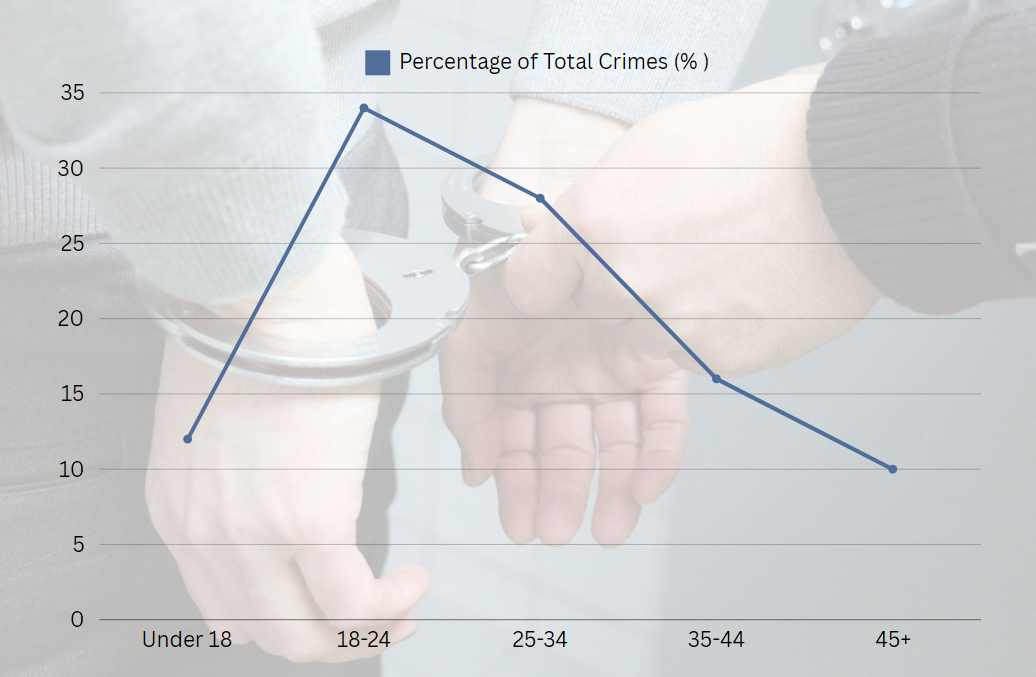The overall Denver crime rate per neighborhood in Denver this year stands at 34.22, reflecting some variations across different areas.
Spanning a vast 155 square miles with a population of about 712,000 within its city limits and nearly 3 million in the wider metropolitan area, stands as a sprawling urban center in the heart of the Rocky Mountains.
This expansive city, with its mix of urban sophistication and outdoor adventure, attracts a diverse array of residents and visitors alike, and it also one of the most dangerous cities in America. Safety in Denver, as in any large city, varies by area and requires a mindful approach to navigate its streets and neighborhoods.
In this post, I will examine the latest crime statistics in Denver and offer useful tips for staying safe.
Table of Contents
ToggleCrime Statistics
Here’s a summary of what I found doing research according to Neighborhoodscout, including my interpretation of the data:
Denver’s safety ranks lower than 1% of U.S. neighborhoods, with a total crime index of 1, where 100 represents the safest areas. Annually, Denver experiences a total of 52,881 crimes, which breaks down into 7,545 violent crimes and 45,336 property crimes. This results in a crime rate of 74.14 per 1,000 residents, with violent crimes at 10.58 per 1,000 residents and property crimes at 63.56 per 1,000 residents.
The likelihood of becoming a victim of a violent crime in Denver is 1 in 95, significantly higher than Colorado’s average of 1 in 203. The violent crime rate in Denver is more than double the national median. Similarly, the chance of experiencing a property crime in Denver is 1 in 16, far exceeding the state average of 1 in 32 and the national median.
Denver’s crimes per square mile stand at 342, vastly surpassing the national median of 27.0, highlighting the city’s struggle with crime density.
The most dangerous neighborhood in Denver for 2024 is Five Points, with 168 violent crimes reported so far this year
Violent Crimes in Denver
| Crime Type | Number of Incidents | Rate per 1,000 Residents |
|---|---|---|
| Murder | 90 | 0.13 |
| Rape | 756 | 1.06 |
| Robbery | 1,301 | 1.82 |
| Assault | 5,398 | 7.57 |
Property Crimes in Denver
| Crime Type | Number of Incidents | Rate per 1,000 Residents |
|---|---|---|
| Burglary | 5,171 | 7.25 |
| Theft | 24,964 | 35.00 |
| Motor Vehicle Theft | 15,201 | 21.31 |
Comparison to Previous Years
In 2024, Denver documented 2,669 violent crimes so far, averaging 13.0 per day. This shows a decrease from the 2023 daily average of 15.1 violent crimes per day as per USNEWS. Property crimes have also declined, with June 2024 reporting 2,480 incidents compared to 3,815 in June 2023. This downward trend suggests effective measures in crime prevention.
The neighborhood with the highest rate of violent crimes in 2024 is Five Points, which reported 168 incidents. Compared to 2023, which saw higher monthly averages, current data reflects an improvement in overall safety.
Citywide Crime Trends
Property crime rates have seen a notable decrease. June 2024 saw 2,480 property crimes, down from 3,815 in June 2023 as noted by Denvercrimes.com. The 2024 monthly average of 2,480 further supports this decline. Analyzing quarterly data reveals that the first quarter of 2024 had violent crime rates nine percent below the past five-year average.
West Colfax had significant crime incidents in January 2024, with Central Park being the neighborhood most affected. These patterns help identify areas needing enhanced law enforcement focus to reduce Denver crime rate.
Possible Crime Reduction
Looking back at 2023, I can see clear signs that crime is returning to pre-pandemic levels, both nationally and here in Denver. Recently released FBI data shows major declines across the country in violent and property crimes, and I’m pleased to say that Denver was part of this encouraging trend.
In 2023, we saw decreases in both violent and property crimes — including murder, aggravated assault, sexual assault, auto theft, robbery, and burglary — compared to 2022. Some of these declines were steep, like the number of stolen cars, which dropped 19%, resulting in nearly 2,870 fewer auto thefts.
There was a reduction of nearly 245 reported violent crime incidents in 2023, driven in part by a 7% reduction in non-fatal shooting incidents and a 5% reduction in homicides.
These reductions didn’t happen by chance. The women and men of the Denver Police Department (DPD) and the District Attorney’s office worked tirelessly, and in partnership, every single day to help bring them about.
Achievements in 2023
Here are some of their achievements in 2023:
- Reduced our average response time for emergency calls by 10 seconds from when the 911 call was placed to a DPD officer arriving on the scene.
- The dedicated DPD auto theft team made 201 auto theft arrests and 45 additional felony arrests for other crimes.
- Officers removed more than 2,235 illegal firearms from the city’s streets.
- Continued our proactive enforcement and outreach efforts in crime hotspots, like the Westwood neighborhood, which didn’t have a single shooting the entire year.
- Created community homicide review events to propose and implement solutions to reduce violence.
- Established more specific guidelines for prosecuting motor vehicle theft and the sale of fentanyl.
- Expanded our Organized Crime Unit by adding two attorneys and two investigators, charging 23 people with aggravated motor vehicle theft, robbery, and burglary.
- Secured more than 70 guns from domestic violence offenders as part of our Firearms Relinquishment Program.
- Filed more than 7,900 misdemeanor cases and more than 5,600 felony cases, successfully prosecuting 51 murder cases.
- Argued and won a case in the Colorado Supreme Court upholding digital evidence search warrants in the Green Valley Ranch arson/homicide case.
- Helped establish a new competency court to better address defendants with mental health issues.
- Expanded our Restorative Justice Program, which has had a 2% recidivism rate among its participants since its inception in 2019.
5 Most Riskiest Parts Of Denver
| Neighborhood | Population | Crime Rate (% above national average) |
|---|---|---|
| Five Points | 8,199 | 108% |
| Capitol Hill | 11,540 | 242% |
| City Park | 6,216 | 172% |
| Central West Denver | 50,475 | 369% |
| Auraria | 740 | 76% |
Five Points
With 8,199 inhabitants, this region’s crime rate stands at a shocking 108% above the Denver average, labeling it as dangerous from the 1960s to the 1990s according to Area Vibes.
Capitol Hill
This neighborhood in Denver, is home to 11,540 people, and it is not particularly safe with an escalating crime rate, which is 242 percent higher than the national average and grows by 4% each year.
Law enforcement officers are frequently spotted at intersections, and residents seem to prefer biking over walking.
Capitol Hill is safer than only 0% of Colorado’s communities according to Area Vibes.
City Park
Home to the Denver Museum of Nature and Science, this diverse neighborhood consists of 6,216 people. The crime rate has shown a steady increase over the years.
In 2023, 6,316 crimes were registered as per the same source.
Central West Denver
With a population of 50,475, is one of Denver’s biggest and, paradoxically, one of the best and worst neighborhoods. Its crime rate is 369 percent above the national average.
Total crime in 2023 was 10,898 per 100k, which is a lot, to be honest.
Auraria
With only 740 inhabitants, Auraria is one of Denver’s smallest neighborhoods.
The crime rate here is slightly higher than the Denver average, but is alarmingly 259% above the national average, making it one of the worst places to live in Colorado.
Neighborhood is primarily unsafe at night, although there are minimal violent incidents during the day.
Now 5 Safest Places in Denver
You all be wondering is Denver safe?
Now let’s try to go through some of the safest neighborhoods
Park Hill
Topping the list of Denver’s safest neighborhoods is Park Hill. With a population of 11,577, it has earned the #1 spot on Niche’s list of Best Neighborhoods to Live in Denver. North Park Hill, in particular, boasts a violent and property crime rate lower than the national average.
This neighborhood features mid-century ranch homes and is highly attractive to young professionals and families. The median household income in Park Hill is $134,467, while the median home price is $567,434.
Congress Park
Home to 10,942 residents, is another of Denver’s safest neighborhoods. It has demonstrated a strong commitment to safety, with reported violent crime decreasing by 18.4% and property crime dropping by 12.9%.
Residents enjoy a vibrant community with numerous bars, restaurants, coffee shops, and parks, contributing to its lively and welcoming atmosphere.
Washington Park
A charming neighborhood in Denver with a population of 7,292. Safety is a top priority here, with a violent crime rate 22% lower than the national average, according to Areavibes.
Niche statistics further highlight Washington Park’s security, with only 13.7 robbery incidents per 100,000 residents, significantly below the national average of 135.5.
University
Adjacent to the University of Denver, the University neighborhood is known for its safety and exclusivity, housing 7,676 residents. It boasts an exceptionally low violent crime rate of 317 incidents per 100,000 people, well below the city average of 932.
Additionally, this community has a remarkably low property crime rate of 3,656 per 100,000 people, compared to Denver’s citywide average of 5,780 cases.
Sloan Lake
Also known as Sloan’s Lake, is a neighborhood and park in Denver with a population of 2,087. The median rent here is $1,701. Sloan Lake is considered very safe, with no reported incidents of murder or rape. Speaking of rent, many people, especially students, are basically forced to find a roommate in order to avoid a 3x rent rule.
Demographic Analysis of Crime
Age plays a critical role in crime patterns. In crime in Denver, data shows that individuals aged 18-24 make up a significant portion of arrests for both violent and property crimes. This age group is often linked to higher crime rates due to various social and economic pressures.
| Age Group | Percentage of Total Crimes |
|---|---|
| Under 18 | 12% |
| 18-24 | 34% |
| 25-34 | 28% |
| 35-44 | 16% |
| 45+ | 10% |
Individuals under 18 are also involved, particularly in property crimes. However, as age increases, the likelihood of committing crimes generally decreases, with those over 45 being the least involved.
Gender Statistics in Crime
Gender differences are evident in Denver crime rates. Males are disproportionately represented in violent and property crimes compared to females. In Denver, approximately 72% of violent crimes and 65% of property crimes are committed by males.
Violent crimes such as assaults and robberies see a higher male involvement. Female participation in crimes is often linked to economic distress and typically involves non-violent offenses like theft and fraud.
| Gender | Violent Crimes | Property Crimes |
|---|---|---|
| Male | 72% | 65% |
| Female | 28% | 35% |
Understanding these differences helps in tailoring intervention and prevention strategies more effectively.
Future Outlook
Predictive crime analytics involves the use of data and algorithms to anticipate criminal activities. By analyzing trends such as seasonal crime patterns and locations of past incidents, law enforcement can deploy resources more effectively. For instance, Denver Crime Rate has seen fluctuations, and understanding these trends can help in addressing hot spots efficiently.
Despite the benefits, there are concerns about bias in data and the ethical use of predictive models. Implementing these tools requires careful oversight to ensure fair and unbiased results. Ensuring transparency and community trust in these technologies will be vital for their success.
Potential Policy Changes and Their Implications
Policy reforms can significantly impact crime rates. Upcoming discussions in Denver may include stricter gun control measures, enhancements in mental health services, and reforms in law enforcement practices.
Stricter gun control has been associated with fewer firearm-related crimes. In 2024, there is potential for policies aimed at reducing the proliferation of guns, which has been a concern as noted in local reports. Enhanced mental health services can also play a role in addressing the root causes of violent behavior, potentially reducing crime rates.
Community Involvement and Future Initiatives
Community involvement is crucial for effective crime prevention. Initiatives that encourage resident participation, such as neighborhood watch programs and public safety workshops, empower communities to take an active role in their safety.
Collaborations between law enforcement and community organizations can lead to more tailored and effective crime prevention strategies. The average number of violent crimes per neighborhood, as recorded in 2024 statistics, suggests that localized approaches could be beneficial. Future initiatives might focus on education, engagement, and fostering stronger community bonds to mitigate crime.
Causes of Crime in Denver
The level of education within a community significantly impacts crime rates.
Higher educational attainment often correlates with lower crime rates, as it provides individuals with better job opportunities and alternatives to criminal behavior.
Conversely, lower educational achievement rates tend to lead to higher crime rates.
In Denver, 82.8% of people have completed high school, compared to the national average of 83%.
Rising living expenses, including increased costs for housing, groceries, utilities, and healthcare, can create financial strain on individuals and families, particularly those with limited financial resources.
Such economic stress may push individuals towards crime, such as theft or burglary, as a means of addressing their financial hardships.
On the other hand, cities with a lower cost of living may alleviate economic pressures, potentially resulting in a reduced crime rate.
Denver’s cost of living is 13.52% higher than the national average, reflecting a more challenging economic environment that could contribute to increased crime levels.
Housing affordability also plays a crucial role in crime rates
. When individuals and families are forced to live in overcrowded or substandard housing conditions due to high housing costs, it can increase stress and potentially contribute to domestic disputes and related crimes. The median home price in Denver is $427,600, compared to the national average of $184,700.
Methodology
For our analysis of Denver crime rate, we use the annual crime data provided by the FBI and the city’s police department. This data comes in two main parts: an initial summary targeting the largest cities in the U.S. and a year-end report.
Our investigation focuses on two main indicators:
- Violent Crime Rates Per Capita
- Property Crime Rates Per Capita














